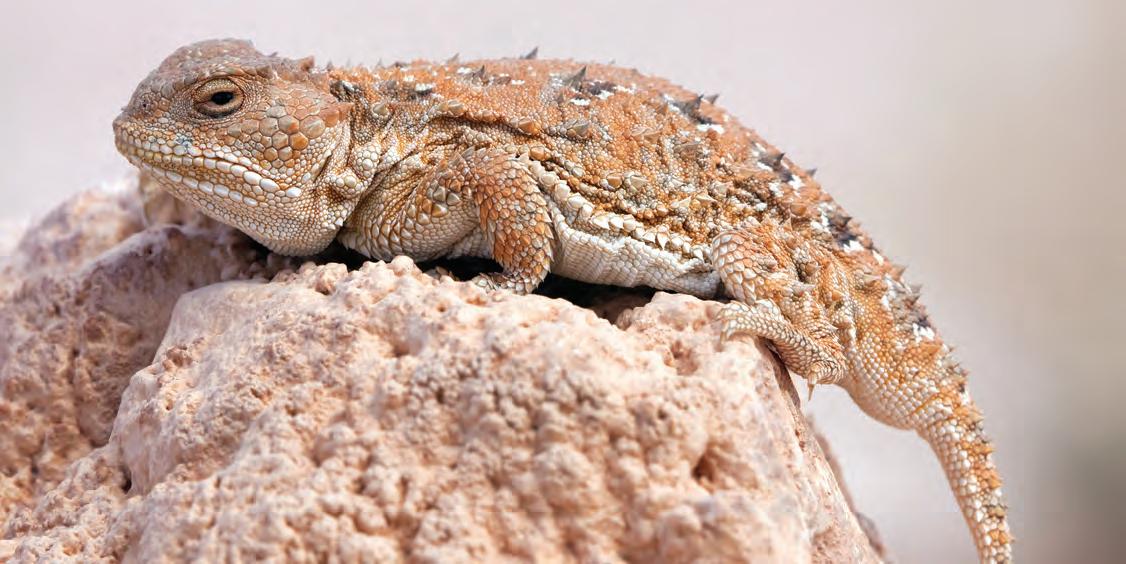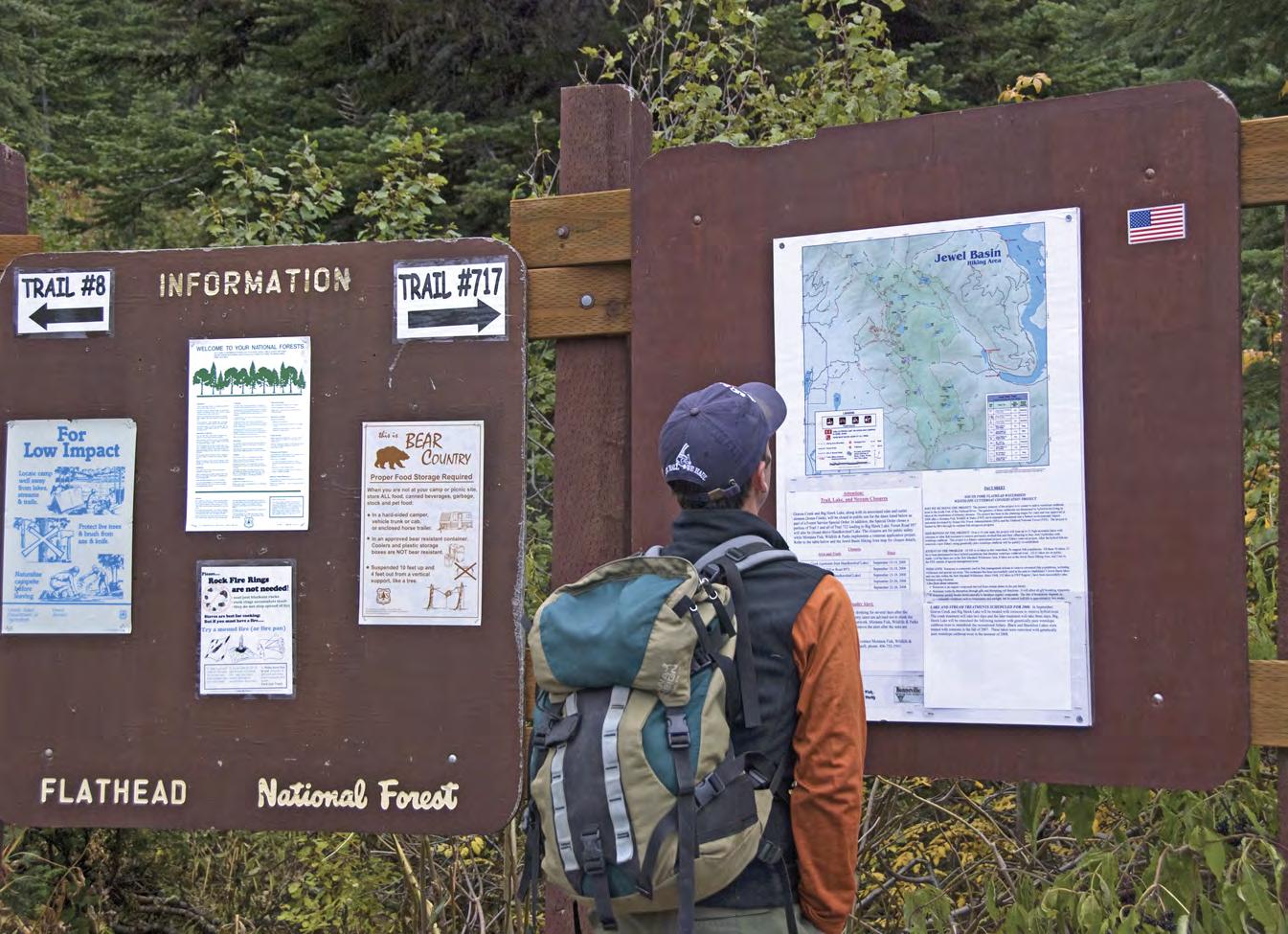
8 minute read
PARTING SHOT Which Route?
top-notch sharptail, pronghorn, mule deer, and elk hunting opportunities. In addition to the new boundary signs, the BLM lands in the project have boxes at parking areas containing detailed maps and GPS waypoints. “Everyone wins,” Nye says. “The pro grams increase recreation on public land and reduce trespass on adjacent private land.” Nye has recently begun an access project along the Milk River from Nashua to Havre and eventually hopes to sign more than 7,000 acres of public land there.
Reducing trespass is especially important for Dennis Hagenston of Billings. An FWP warden captain when he retired in 2003, Hagenston now works part-time for the department as a hunting access technician for the Block Management Program in fall and signs public lands in spring. “My years as a warden have helped me spot places where signs can solve potential problems,” he says. “I can see where hunters might get confused, so I put signs in those spots to make that less likely.”
Each of the three FWP signers takes a slightly different approach. After consulting DNRC staff, Hagenston focused first on signing accessible school trust lands in south- central Montana, then moved to signing BLM lands. Nye only signs lands that are part of projects that have additional objectives such as increasing deer and elk harvest to reduce depredation on neighboring croplands. Andrews, who calls himself an “equal opportunity signer,” says he has tried to methodically cover almost every BLM and school trust property in southeastern Montana. “I don’t pick the sites on physical characteristics. I just get out there on all the tracts we have approval to sign. Some of them might not appear to have much value for recreational use, like stubble fields or heavily grazed areas. But you never know. They could be used by antelope or geese,” he says.
Boundary indicators alone aren’t enough, Andrews adds. Hunters and others must carry a compass or GPS along with accurate maps they know how to read. “The signs are only saying, ‘Okay, the public land begins here,’” he says. “Then it’s up to hunters to figure out where they are and how the land lays.” Andrews avoids signing small quartersection parcels because he thinks it’s too easy for people to end up trespassing. “I don’t sign anywhere where I think it would cause problems,” he says. “We have to be respectful of landowners.”
Landowners reciprocate. Hagenston says almost all lessees and permittees notified about signs have cooperated. “They know recreationists have legal access to this land if a county road bisects it.” Andrews says landowners are coming around to the fact that they no longer control access to most school trust lands. “I can’t say most of them are thrilled about the lands being signed. But the program has been in place for nearly two decades, so I think they are getting used to it,” he says. “I had one landowner come out and watch me do the entire border of a big tract that abutted his property. He’d stop and shoot the breeze, and we kind of developed a relationship. By the third day he was helping me out.”
Their biggest challenge now, say Andrews and Hagenston, is replacing old markers. Some people shoot the signs for fun, and cattle tip over signs while using them as scratching posts. The worst vandal is the harsh prairie sun. After a few years, signs fade and need to be replaced. “The moment you put one of these up, you create a potential maintenance problem,” Andrews says as he tightens a nut to secure a new DNRC sign to its post. “I think about that every time I do this, because at some point I won’t be around here to replace it.”
Walking back to his truck, Andrews reflects on a decade of helping hunters and others discover land that was already theirs: “It’s a good feeling to get outside and do something tangible, to know I’m doing something important that might not get done otherwise.” Tom Dickson is editor of Montana Outdoors.
MAN ON A MISSION Above: A BLM map with Dwayne Andrews’s detailed notes. Below: Andrews with a decade’s worth of data showing where he has signed 320,000 acres of public land.

HUNTERS: Take another look
Though many state and BLM sections appear devoid of game, it can be worth scouting even the grimmest-looking parcels. Two hunting buddies of mine regularly scour state and BLM sections and continually discover pockets of prime pheasant and mule deer cover. A few years ago, one of them shot three limits of roosters on a parched little state half-section that from the road looked like a moonscape. He’d taken the time to walk the perimeter and found, over a slight rise hidden from passersby, a lush springfed swale that attracted cock birds all fall. I’ll bet hundreds of pheasant hunters drove by that parcel over the years and never gave it a moment’s thought. —Tom Dickson

Greater Short-horned Lizard

Phrynosoma hernandesi By Ellen Horowitz

When friends told me they’d seen greater short-horned lizards by the Sun River west of Augusta, I had to check out the spot. I was curious about the prehistoric-looking creatures.
Could they really squirt blood from their eyes, as a Texas naturalist once informed me?
What’s more, because they are generally lizards of the open plains, most commonly found in southeastern Montana, this sighting just a few miles from Gibson Reservoir meant I didn’t have to drive completely across the state to see one.
APPEARANCE The greater short-horned is one of four lizards in Montana. Commonly called a horny toad or horned toad, it technically is not a toad (amphibian) but a lizard (reptile). The confusion is understandable. The greater short-horned lizard has a broad toadlike shape, and its scientific name, Phrynosoma, is Greek for “toad body.”
The lizard has an oval, flattened body, a heart-shaped head (when viewed from above), a single row of light-colored scales along its sides, and small, hornlike projections near the back of its head. The lizards are only 2.5 to 3.5 inches long, with males smaller than females.
Even though my friends had told me almost exactly where to look for the little reptiles, finding one wasn’t easy. Their body color varies widely, from tan-gray to reddish brown to olive green-gray. “They blend in spectacularly with the ground where they live,” says greater short-horned lizard expert Jim Barron, associate professor of biology at Montana State University—Billings. Dark splotches, white spots, and abundant spines and scales enhance the animal’s camouflage.
HABITAT AND HABITS Of the 13 horned lizard species in North America, the greater short-horned is the most widespread, ranging from southern Alberta to northern Mexico. It occurs east of the Rocky Mountain Front in dry, open habitat. Generally, the bleaker the natural landscape, the more likely you’ll find greater short-horned lizards. In Montana, scientists have found them as high as 6,500 feet in the Pryors, on ridge crests between coulees, in sparse grass, and in sagebrush with sunbaked soil.
The lizards usually mate in early May shortly after emerging from their winter burrows. As the young grow inside her, the female becomes round in shape, “like a racquetball with legs,” says Barron. By the time she gives birth to her ten or so young, anytime between late July and early August, her weight has doubled.
EAT OR BE EATEN A greater short-horned lizard may not look appetizing to us, but it is tasty prey to snakes, raptors, ravens, foxes, coyotes, and other animals. In addition to its cryptic coloration, the lizard stays alive by staying still. That’s also how it hunts. When an unsuspecting insect wanders close enough, the lizard strikes. The greater short-horned feeds on crickets, beetles, grasshoppers, and ants—especially the western harvester ant.
When spotted by a predator at close range, the lizard often responds by holding open its mouth or performing “pushups” from all four legs—behaviors known as threat postures. It can also inflate its lungs to puff up and enlarge its appearance, which makes a snake think twice about how far it wants to unhinge its jaws to devour dinner.
And what about that ocular blood squirting? Barron tells me that even though it’s true many horned lizard species emit blood from their eyes during extreme stress, Phrynosoma hernandesi is not one of them.
THE FUTURE My husband and I had spent two hours looking for the lizards before he spotted a skittering “rock” that abruptly stopped. He called me over. “Horned toad,” he said. “Look by my left boot.” It took me nearly a minute to locate the motionless form hidden against a backdrop of grayish brown earth and a few strands of prairie grass. The lizard never moved the whole time I watched it, even when I bent down to take photographs.
The greater short-horned lizard is listed as a Montana species “of concern” because its habitat is being altered. According to Barron, the loss of native prairies to agricultural conversion, overgrazing, and fire suppression are the major threats to this secretive little lizard. Ellen Horowitz is a writer in Columbia Falls.
PARTING SHOT

WHICH ROUTE? A hiker looks for the trail to Mount Aeneas, in the Flathead National Forest east of Kalispell. The 5.9-mile loop to the scenic peak and back is one of ten can’t-miss day hikes we feature beginning on page 8. Photo by Becky Lomax.




